Do I Need to Periodize?
The main value of periodization for all trainees comes from the fact that you cannot optimally impro...
| July 15, 2021
Read time: 3 min.

My philosophy has always stood around programming training around multi-joint movement and ensuring the body’s stabilizers and proprioceptors are working properly. At a baseline, every single individual should be able to squat, hinge, push and pull safely and effectively.
There are, of course, variables that may put limitations on how far each individual can do these movements. If they can not, it should be made a priority as foundational work before any type of overload is put into their gym regime.
These compound movements (multi-joint exercises) not only burn the most calories and build the most muscle mass, they also reinforce several other benefits behind overall wellness and health, such as spinal health, balance, posture and core strength, as well as muscular endurance and conditioning. Compound movements are always the best way to increase strength over the entire body and overload can best be done this way. With overload (moving heavier loads) comes higher amounts of controlled resistance, behind this comes higher degree of stimulus and tension on the muscle, leading to higher tear, higher recovery and ultimately more lean muscle mass that will burn more fat and make you a much more effective unit overall.
With that said, when structuring a good workout, unless you are warming up you should always begin your training session with a compound movement (at least for powerlifting and hypertrophy). We have a limited amount of energy to expend each training session and choosing specifically how to use this energy can seperate a good workout from a bad one. The only way to improve is to spend an appropriate output for exercises to create adaptation.
For example, for someone who is trying to develop muscle mass, given that their body will allow them to perform it safely and effectively, while training pecs, start with the bench press. Being a compound, it requires the most energy expenditure for the pecs, it also involves other areas such as the triceps, delts, lats, and rhomboids as well as several others including the core. So to pre-exhaust the secondary muscles before this compound would make maximum efforts towards effectiveness in overload futile. On the contrary, if you were to train compound first, then follow it with secondary movements, you’ll have stimulated muscle to grow in the compound, then by the time you move to isolation, they will already be worked, making them stronger and more capable to handle the isolated portion. The advantage to doing this is that whichever area you isolate or put direct hypertrophy towards, you can branch off and put more volume towards that specific area. It leaves options very open and possibilities endless.
That being said, if you overuse machines, this can really weaken your stabilizers and in turn, not only make you lose strength, but also can lead to injury. You may train the body to only use the areas you were isolating and when it comes time to do a functional movement, your mind muscle connection might only be adapted to that said exercise that you are used to performing and the lacking areas might take the blunt of whatever unnatural movement may occur, this is of course a hypothetical situation. Ultimately, you should create diversity in your training program, between using compounds, free weights, cables and stabilized systems. They all have a place and should be used appropriately and safely to maximize effectiveness and growth.
In the case of trying to build the hamstrings, quads or glutes, do your compounds first too. By doing so, it will again tie back to strength, the stronger you are in your squat the more isolated weight you can handle in something such as the leg extension or hip thrust. Whereas with the deadlift, it will enable high capabilities to movements such as the romanian deadlift and hamstring curls.
This same notion can be applied to your core, you would not want to make your core fatigued before doing something that relies on it so heavily, but if you were to do these core reliant exercises first and thereafter isolate the core, it will have already been simulated and utilized, where you can separate it into different portions (rectus abdominis, transverse abdominis, obliques, linea alba, erectors, QL) depending on your goals, whether it be visual or performance based.
New articles, content with tips, inspiration, and coaching directly to your inbox.